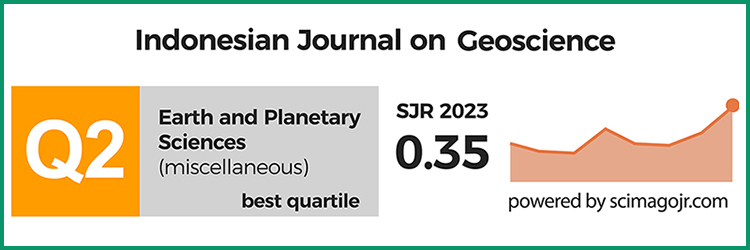Nannoplankton Assemblage Succession Throughout Cretaceous/ Tertiary Boundary in the “P” Well Section, Santos Basin, Brazil
DOI:
https://doi.org/10.17014/ijog.6.1.51-68Keywords:
biostratigraphy, nannoplankton, Cretaceous/Tertiary (K/T) boundary, Santos Basin, BrazilAbstract
The massive change in calcareous nannoplankton assemblages throughout Cretaceous/Tertiary (K/T) boundary (65.5 M.a.) has been illustrated by several authors. The diverse and abundant assemblage disappears suddenly above the Cretaceous/Tertiary boundary. This event is related to the most dramatic environmental changes in the Earth's history due to the catastrophic events, those are meteorite impact (Chicxulub) and supervolcano eruption (Deccan) occurring at the end of Cretaceous. The succeeding age was a time of rapid evolution of nannoplankton during Paleocene. A quantitative method analysis of nannoplankton throughout Maastrichtian to Paleocene of “P” well section, Santos Basin, Brazil, indicated that the nannoplankton assemblages abruptly decrease in diversity and abundance and mostly change in species composition. The various complex shapes of species at Maastrichtian also underwent changing to simple plain shapes and small at Paleocene. The sedimentary section ranges from the top of zone CC23 (Coccolith Cretaceous 23) to NP9 (Nannoplankton Paleogen 9). It is bounded by the Last Occurrence (LO) of Tranolithus pachelosus at the base and Fasciculithus tympaniformis at the top. The biostratigraphic discontinuity characterized by the absence of zone CC26 to NP4 is an indicator for the presence of an unconformity at K/T boundary within analyzed section. The Cretaceous nannoplankton assemblages are dominated by Genera Watznaueria, Micula, Arkhangelskiella, Cribrosphaerella, Eiffellithus, Predicosphaera, and Retecapsa, whilst the Paleocene assemblages are dominated by Genera Toweius, Ericsonia, and Coccolithus. Survivor Cretaceous species recovered into Tertiary sediments consist of Braarudosphaera bigelowii, Biscutum melaniae, Neocrepidolithus neocrassus, Placozygus sigmoides, Cyclagelosaphaera reinhardtii, Markalius inversus, and Scapolithus fossilis.
References
Alvarez, L.W., Alvarez, W., Asaro, F., and Michel, H.V., 1980. Extraterrestrial cause for the Cretaceous-Tertiary boundary extinction. Science, 208, p.1095-1108. DOI:10.1126/science.208.4448.1095
Bagni O. 2007. Brasil Round 4, Santos Basin, Block Definition Superintendency. https://www.anp.gov.br/brasil-rounds/round4/round4/workshop/restrito/ingles/Santos_ing.pdf.
Bown, P.R., 1999. Calcareous Nannoplankton Biostratigraphy. Kluwer Academic Publishers, p.1-314.
Bramlette, M. N. and Martini, E., 1964. The great change in calcareous nannoplankton fossils between the Maestrichtian and Danian. Micropaleontology, 10, p. 291-322. DOI:10.2307/1484577
Geolor’s Earth Issues, 2007. Earth's Major Extinctions. https://www.geolor.com/EarthIssues/Earth_Major_Extinction_geolor.htm (25 Jan 2007).
HIS, 2007. Information on Brazil, Santos Basin. https://maps.ihs.com/basin-monitor-ordering-service/latin-america/santos-basin.html (30 Jan 2007).
Joshua, H., 2007. Play potential in the deepwater Santos basin, Brazil. Rosenfeld - Yax Balam Inc., Hood, J. F. - Veritas DGC. https://www.pennenergy.com/index/petroleum/display/272394 articles/offshore/volume-66/issue-9/geology-geophysics/play-potential-in-thedeepwater-santos-basin-brazil.html [30 Jan 2007].
Martini, E., 1971. Standard Tertiary and Quaternary calcareous nannoplankton zonation. Proceedings, 2nd Planktonic Conference, Roma, p.739-784.
Okada, H. and Bukry, D., 1980. Supplementary modification and introduction of code numbers to the low latitude coccolith biostratigraphic zonation. Marine Micropaleontology, 5 (3), p.321-5. DOI:10.1016/0377-8398(80)90016-X
Perch-Nielsen, K., 1969. Die coccolithen einiger dänischer Maastrichtien - und Danienlokalitäten. Bulletin of Geological Society, Denmark, 19, p.51-66.
Perch-Nielsen, K., 1979a. Calcareous nannofossil zonation at the Cretaceous/Tertiary boundary in Denmark. Proceedings, Cretaceous/Tertiary Boundary Event Symposium, Copenhagen, 1, p.115-35.
Perch-Nielsen, K., 1979b. Calcareous nannofossils in Cretaceous/Tertiary boundary Sections in Denmark. Proceedings, Cretaceous/Tertiary Boundary Event Symposium, Copenhagen, 1, p.120-6.
Perch-Nielsen, K., 1981. Les nannofossiles Calcaires â la Limite Crètacè-Tertiaire près de El Kef, Tunisie. Cah. Micropaleontology, 1981, 3, p.25-37.
Perch-Nielsen, K., 1982. Maastrichtian Coccolith in the Danian: Survivors or Reworked “Dead Bodies”? Abstract, IAS Meeting, Copenhagen, 122.
Perch-Nielsen, K., 1985. Cenozoic Calcareous Nannofossils, In: Bolli, H.M., Saunders, J. B. & Perch-Nielsen, K. (eds.), Plankton Stratigraphy. Cambridge University Press, p.329-554.
Percival, S. F. and Fischer, A. G., 1977. Changes in calcareous nannoplankton in the Cretaceous-Tertiary Crisis at Zumaya, Spain. Evolution Theory, 2, p.1-35.
Romein, A. J. T., 1977. Calcareous nannofossils from the Cretaceous/Tertiary boundary interval in the Barranco del Gredero (Caravaca, Prov. Murcia, SE Spain). Proceedings, Koningklijke Nederlandsch Akademie Wetenschappelijk, 80, p.256-79.
Sharpton, V.L., Dalrymple, G.B., Marin, L.E., Ryder G., Schuraytz, B., and Urrutia, F.J., 1992. New links between Chicxulub impact structure and the Cretaceous-Tertiary boundary. Nature, 359, p.819-821. DOI:10.1038/359819a0
Sissingh, W. 1977. Biostratigraphy of Cretaceous calcareous nannoplankton. Geologie en Mijnbouw, 56, p.37-65.
Wikipedia, 2007. Cretaceous-Tertiary extinction event. https://en.wikipedia.org/wiki/Cretaceous. Tertiary_extinction_event [25 Jan 2007].



















